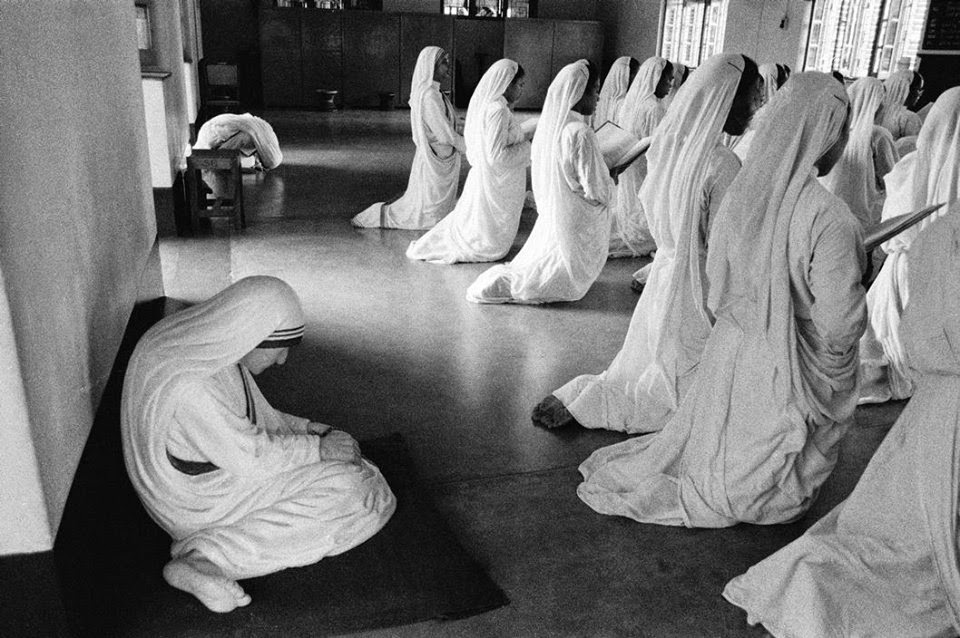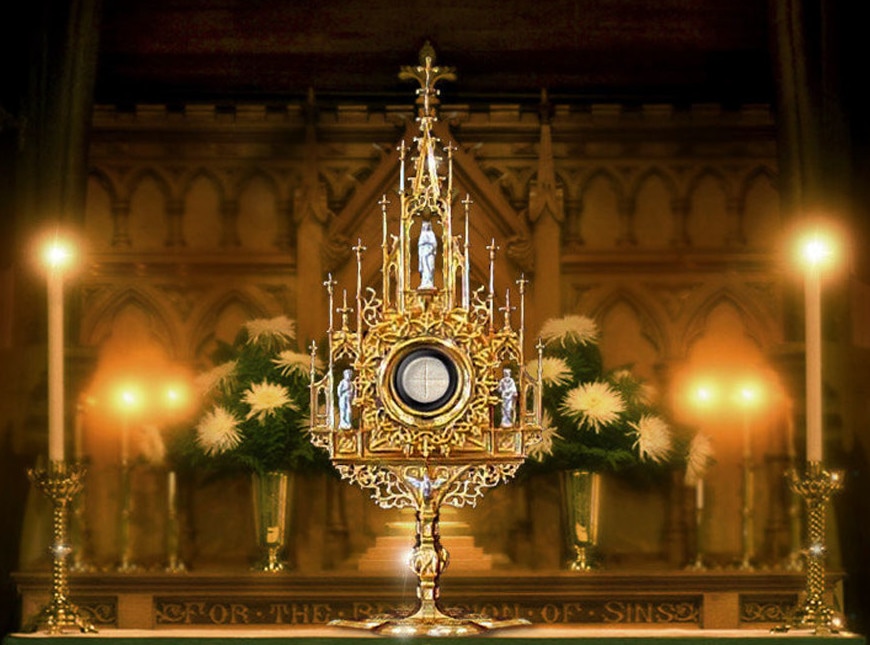
For this reason back in 1946-47 when she was writing the very first Constitutions for the future Congregation of the Missionaries of Charity which she was asked by Jesus, her Crucified Spouse, to found, she writes: ‘The Sisters should use every means to learn and increase that tender love for Jesus in the Blessed Sacrament” (R. 34; MFG, p. 31).
Bl. Teresa not only renewed daily her “call within a call” to give wholehearted free service to the poorest of the poor at every Eucharistic celebration, but also drew her strength from its daily reception. She writes: “One thing I request of you, Your Grace, is to give us all the spiritual help we need. If we have our Lord in the midst of us, with daily Mass and Holy Communion, I fear nothing for the Sisters nor myself; he will look after us. But without him I cannot be — I am helpless” (MFG, p. 26).
She even wanted the Sisters to do the work of priests. In her original Rule Book she writes: “As each Sister is to do the work of a priest — go where he cannot go and do what he cannot do, she must imbibe the Spirit of Holy Mass, which is one of total surrender and offering. For this reason, Holy Mass must become the daily meeting place, where God and his creature offer each other for each other and the world” (MFG, p. 31; R. 33).
Here we see Bl. Teresa’s deeper understanding of the reality of the Eucharist and her mystical union. It was this unbroken spousal union that gave her all the energy, strength, vitality and enthusiasm to go on doing what she did.
The life she lived was no longer her life, but it was Jesus who lived in her and worked through her. She was able to do all things in Jesus, for Jesus and with Jesus, who strengthened her through daily reception of the Eucharist.
What did Bl. Teresa hear?
In her first letter to the Archbishop of Calcutta, Ferdinand Perier, S.J., written on 13 January 1947, she wrote: “One day at Holy Communion I heard the same voice very distinctly” (MFG, p. 10).
What did Bl. Teresa hear from the Eucharistic Jesus?
1. The kind of nuns she should have and the qualities they should possess:
— I want Indian nuns, victims of My love, who would be Mary and Martha, who would be so united to Me as to radiate My love on souls.
— I want free nuns, covered with the poverty of the Cross.
— I want obedient nuns, covered with the obedience of the Cross.
— I want full-of-love nuns, covered with the Charity of the Cross.
2. She heard the kind of people she and her nuns should take care of:
— There are plenty of nuns to look after the rich and well-to-do ‘ people but for My very poor people, there are absolutely none. For them I long, them I love. Wilt thou refuse?
3. The name of the Congregation Jesus wanted her to found:
— I want Indian Missionaries Sisters of Charity who would be My fire of love amongst the very poor, the sick, the dying, the little street children.
4. She heard very distinctly that she and her nuns should bring the poor to him:
— The poor I want you to bring to Me.
— The Sisters who offer their lives as victims of My love should bring these souls to Me.
5. The Eucharistic Jesus told her that:
— You are, I know, the most incapable person, weak and sinful, but just because you are that, I want to use you for My glory. Wilt thou refuse?
6. Jesus told her the kind of habit she should wear:
— You will dress in simple Indian clothes or rather, like My Mother, dressed, simple and poor,… your sarie will become holy because it is My symbol.
7. Jesus told her very clearly what exactly was her vocation:
— Your vocation is to love and suffer and save souls.
8. He told her that she is his little spouse and that she would suffer very much:
— You are My own little spouse, the spouse of the Crucified Jesus; you will have to suffer these torments in your heart.
It was her Eucharistic Spouse who promised that he would never leave her, provided she trusted him lovingly and blindly, obeyed him cheerfully, promptly and without any questions (cf. MFG, p. 18).
In the account of the second vision, Our Lady told Bl. Teresa to take care of her poor people and carry Jesus to them. Her exact words were: Take care of them, they are mine; bring them to Jesus, carry Jesus to them (MFG, p. 19).
Here Our Lady apparently wanted Bl. Teresa to continue to do what she did immediately after the Annunciation.
At the Annunciation Mary received Jesus first in her heart and then in her womb, and then with Jesus she went in haste to give him to her cousin Elizabeth and others. “The Annunciation was Our Lady’s first Holy Communion day”, Bl. Teresa said.
Just as Mary received Jesus at the Annunciation and then went in haste to give him to others, so too all Missionaries of Charity Sisters and Brothers receive Jesus in Holy Communion and go in haste to give to the poor. Our Lady told Bl. Teresa to bring the poor to Jesus and carry Jesus to them. She also promised her unfailing help: Fear not, Jesus and I will be with you and your children.
Christ in the poor

Jesus wants Bl. Teresa, the Sisters and the Brothers to go among the poor not as social workers, politicians or even masters; but as unworthy servants asked to carry Jesus with us into the people’s homes and holes.
Jesus wants us to visit the people, but he cannot go alone. He is helpless to do his work without us; we are helpless to do his work without him. “Apart from me you can do nothing” (Jn 15:5). “I can do all things in him who strengthens me” (Phil 4:13). There is a reciprocal helplessness and a mutual strength.
In a sense, Jesus depends on us to save souls, and we depend totally on Jesus for our life and work, as electricity and bulb. Through the bulb the electricity becomes luminous and useful.
Our Bl. Teresa goes further and deeper with her Eucharistic Jesus. In her own words: “Just as Jesus allows himself to be broken, to be given to us as food, we too must break, we must share with each other, with our own people first, in our house, in our communities, for love begins at home.
“Every Holy Communion fills us with Jesus and we must, with Our Lady, go in haste to give him to others. For her, it was on her first Holy Communion day that Jesus came into her life, and so for all of us also. He made himself the Bread of Life so that we, too, like Mary, become full of Jesus. We too, like her, be in haste to give him to others. We too, like her, serve others” (Talk to the Brothers and Co-workers, Los Angeles, U.S.A., 1 July 1977).
According to Bl. Mother Teresa, Jesus in the Eucharist keeps us zealous, fervent and enthusiastic. Love for the Eucharist helps us to love the poor, for she says: “Try to be Jesus’ love, Jesus’ compassion, Jesus’ presence to each other and the poor you serve. Humility always is the root of zeal for souls and charity. We see that in Jesus on the Cross and in the Eucharist” (Letter, June 1990).
The Eucharistic Jesus little by little took possession of our Mother Teresa, transforming her whole being so utterly into him so that she could become Jesus for all. People looked up and no longer saw her, only Jesus.
Like a piece of iron stuck to a magnet, she became one with her beloved Spouse, whom Jesus himself addressed as his little spouse: “You are my own little spouse, the spouse of the Crucified Jesus” (MFG, p. 11).
‘To be really only his’
In Bl. Teresa there was the insatiable spousal longing, which became identical with the thirst of Jesus on the Cross for love of souls. From now on, she was going to pray, suffer and work day and night for Jesus, because her beloved Spouse was everything for her: “Jesus, my own Jesus, I am only thine… I love you not for what you give, but what you take, Jesus” (MFG, p. 17).
She continues in writing to the Archbishop of Calcutta: “I long to be really only his, to burn myself completely for him and souls. I want him to be loved tenderly by many… I have already given my all to him” (MFG, pp. 13-14).
The Eucharist and the poor are inseparable. This is not anything new for the Church, for we can clearly see it in the Gospels. The One who said, “This is my body” is the same one who said, “I was hungry and you gave me to eat…” (cf. Mt 26:26; 25:35).
Some of the Fathers of the Church, such as St. Ambrose and St. John Chrysostom, were very clear and emphatic in their pronouncements.
St. John Chrysostom, for example, said: “Do you wish to honour the body of Christ? Do not ignore him when he is naked. Do not pay him homage in the temple clad in silk, only then to neglect him outside where he is cold and ill-clad. He who said: ‘This is my body’ is the same who said: ‘You saw me hungry and you gave me no food’, and ‘whatever you did to the least of my brothers you did also to me…’. What good is it if the Eucharistic table is over loaded with golden chalices when your brother is dying of hunger. Start by satisfying his hunger and then with what is left you may adorn. the altar as well”.

The Holy Father, John Paul II, writes to the youth of the world on the occasion of the XIX World Youth Day 2004: “Dear friends, if you learn to discover Jesus in the Eucharist, you will also know how to discover him in your brothers and sisters, particularly in the very poor.
It is with such inner freedom and such burning charity that Jesus teaches us to find him in others, first of all in the disfigured faces of the poor.
Bl. Teresa of Calcutta loved to distribute her “visiting card” on which were written the words: “The fruit of silence is prayer; the fruit of prayer is faith; the fruit of faith is love, the fruit of love is service; the fruit of service is peace. This is the way to meet Christ…”.
Let us go out and meet him in the poor, making our love all the more fruitful in service. Let this be our unquenchable thirst, constant effort and fervent prayer.
